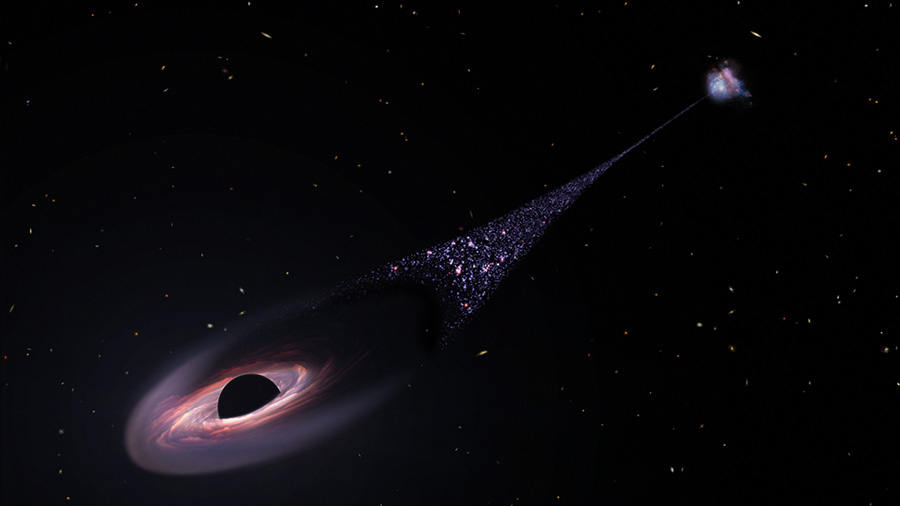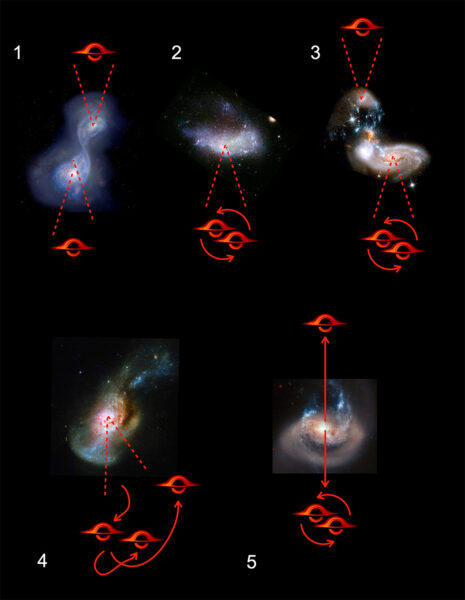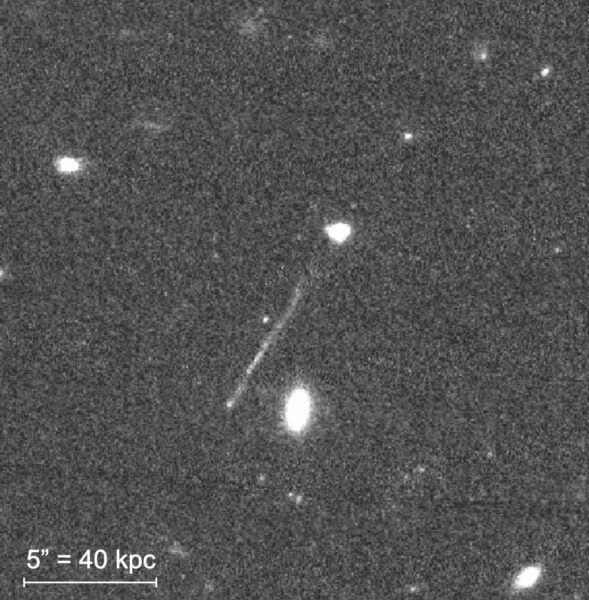An unusual stellar streak emerging from a distant galaxy might be a sign of a runaway supermassive black hole, scientists suggest.
Updates:
(April 6, 2023) This work has now been published in The Astrophysical Journal Letters. An accompanying news release from Hubble can be found here.

NASA / ESA / Leah Hustak (STScI)
Supermassive black holes reside in the centers of most large galaxies. The question is: Do these hungry behemoths ever escape from their hosts to roam freely in the void?
Scientists might have just spotted one such runaway supermassive black hole, according to a new study to appear in the Astrophysical Journal Letters (preprint available here). Their clue is a Hubble Space Telescope image, on which a narrow streak of stars is emerging from a distant galaxy.
Predicted, But Hard to Find

Pieter van Dokkum et al. / Astrophysical Journal Letters 2023
There are several ways for a supermassive black hole to escape from a galaxy's center.
When two galaxies crash into each other, their supermassive black holes coil toward the center of the gravitational well like roulette balls on a spinning wheel. It can take hundreds of millions or even billions of years, but eventually the black holes’ inward spiral leads to their merger — an event that can impart a kick to the newly formed black hole, ejecting it from the center.
“Recoiling black holes are a natural outcome of our models,” says Marta Volonteri (Institute of Astrophysics of Paris), who has studied simulated collisions of supermassive black holes.
The situation can get more complicated: Before two black holes merge, another galaxy might drop by, donating a third black hole. The trinity's ensuing gravitational dance can kick one of them — usually the one with the lowest mass — from the nucleus with enormous velocity.
Despite the predictions, scientists are still searching for their first runaway or recoiling black hole. The most compelling candidate to date is a quasar known as 3C 186, which appears to be offset from its host galaxy's center.
However, the serendipitous discovery reported in the new study might give the quasar a run for its money.
Streak Of Stars

Pieter van Dokkum et al. / Astrophysical Journal Letters 2023
What piqued scientists’ interest was an almost straight trail of stars emerging from a dwarf galaxy. At first glance, the feature resembled jets spewed out by active galactic nuclei, but a close examination showed that its properties are unlike anything seen before. For one, the light shows clear signatures of starlight rather than plasma, unlike typical jets. The trail’s shape — pencil sharp at the top and somewhat wider close to the galaxy — is also exactly the opposite from what we associate with AGN jets.
The team suggests that we are looking at the trace of a runaway black hole as it travels through the gas surrounding its galaxy at some 1,600 kilometers per second (3.5 million mph). The black hole's passage shocks the medium, prompting the formation of stars in its wake.
“It's really quite uncanny how similar it looks like our pictures,” says Volonteri, whose team has been predicting similar trails in the past. Volonteri wasn't involved in the new study.
Intriguingly, a closer scrutiny of the area revealed a second, much fainter trail on the opposite side of the galaxy. Again, the well-known bipolar jets from active galactic nuclei come to mind as the obvious explanation, but the evidence just doesn’t add up. “We discussed that a lot,” says Grant Tremblay (Center for Astrophysics, Harvard & Smithsonian), who contributed to the study. “I'm just really convinced that it can’t be a bipolar outflow — it just doesn’t make sense.”
The team speculates that the galaxy, whose irregular shape and enthusiastic formation of stars suggest a recent collision, originally harbored three black holes. As the lightest black hole was ejected to create the bright trail, the remaining duo was kicked out in the opposite direction with somewhat lower velocity.
It is too early to claim a discovery of a runaway supermassive black hole, let alone three. However, there are ways to get a better handle on the trails’ origin. The team is especially interested in a bright spot at the tip of the brighter trail, where the black hole might lurk. “The detection of an X-ray point source on the top of that tail would be a dead ringer for an accreting black hole,” says Tremblay.
In the next couple of years, the astronomy community will undoubtedly observe the feature with various observatories from the ground and space, says Tremblay.
 1
1









Comments
gary camp
February 23, 2023 at 3:08 pm
Sounds like a job for Webb. I would like to see the speed spectrum of each part of the streak. Seems like it should be curved near the galaxy.
You must be logged in to post a comment.
You must be logged in to post a comment.